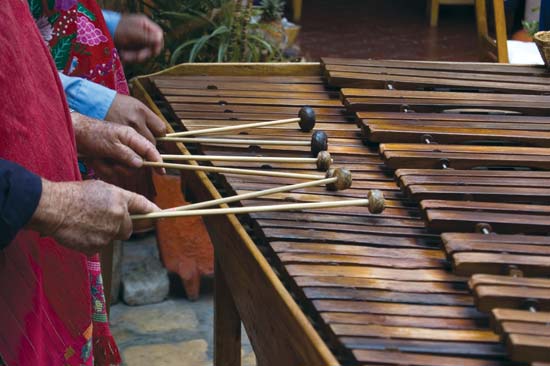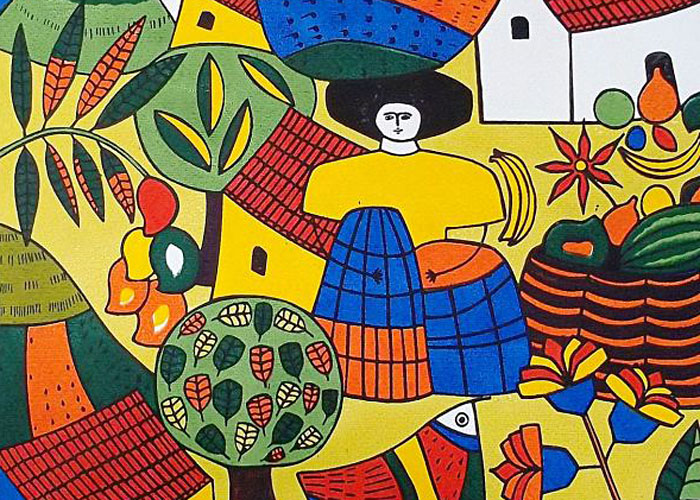Music and Dance
|
Long before the Spanish conquest, music played an important part in Salvadoran life. Archaeologists have found various kinds of musical instruments – whistles with several tones, pipes with as many as six finger holes, and drums of wood or clay called huehuetle, originally covered with deerskin. The marimba, a wooden xylophone, also has a long history and is still played. Salvadoran Cumbia is a staple in Salvadoran music. Groups such as Orquesta San Vicente who sing (Soy Salvadoreño), the Bravo group who sing (Sabrosa Cumbia) and the Hermanos Flores group who sing (Mi País) are three well known cumbia music groups in El Salvador. As well, hip-hop and reggaeton groups have a growing influence on the music scene, embracing the story telling ethos of Salvadoran literature. Traditional dance is a blend of Spanish and indigenous influences. This music includes religious songs (mostly Roman Catholic) used to celebrate Christmas and other holidays, especially feast days of the saints with Tubular bells Chimes. Satirical and rural lyrical themes are common and played with Xylophone. |
 |
|
On festival days, people in colorful costumes act out tales in song and dance. Decorated wooden masks represent stock characters, such as a fool with a monkey face. Popular styles in modern El Salvador include Salvadoran Cumbia, Salvadoran hip hop, Rock and Native Mesoamerican Indigenous music which historically have had a long and large significance and impact on modern El Salvador music styles. Today the El Salvador Opera is on a mission to be recognized as the premier destination in Central America for live theater, variety shows, and opera. It develops artistic talent, works with local children, and produces professional performances. |
|
|
Folk art and painting Salvadorans are famous for their lively folk art, especially ceramics. Brightly painted clay objects often use native and peasant symbols. A specialty is sorpresas (surprises) – little painted figures under a walnut-sized clay shell. Wood carvers create masks, Spanish riders, religious items, and traditional peasant dolls. Painting is the most important modern art in El Salvador, with a long history of excellence. A Salvadoran national school of painting developed in the early twentieth century. Notable painters of this school were Juan Francisco Cisneros and Miguel Ortíz Villacorta. His experimental art displays the same interest in the inner life that his stories do. He experimented with “automatic” painting, for instance, letting his hand paint without interference from his conscious mind. Notable among modern painters is José Mejía Vide. He depicts the lives of ordinary people and the villages of his home country. The paintings of Noé Canjura are full of social and religious themes, such as his painting Índian Christ. The vibrant and colorful art of Fernando Llort is rooted in folk traditions. In the 1970s, Llort founded an art center at La Palma, Chalatenango. With his support, the artisans of La Palma have become well known. |
 |
Literature
Hard working, efficient and optimistic, Salvadorans are very pleasant to work and socialize with. The Salvadorans are storytellers, and thanks to their eventful history, they have no shortage of tales. While there were always writers, El Salvador’s literary traditions bloomed with the Spanish Romantics of the 1800’s, with well-known poets such as Juan Jos Ca as (1826-1918) who also wrote the National Anthem. They oversaw the rise of Liberalism and Modernism, helping found El Salvador’s first university (1841) and library (1870), stocked with classical Greek texts and offering an environment where students and historians would begin to put together true written histories of the country.
Writers like FransiscoGavidia(1864-1955), after criticizing El Salvador’s florid poetic traditions, began writing more profound narratives with indigenous and modern themes. The result was what is now considered a true Salvadoran style, wrought with emotion, sarcasm, and often delivered in bite-sized stories and poems rather than drawn out tomes.
Alvaro Men n Deslal (1931-2000), a journalist and quirky character who held diplomatic posts in Europe, published strange science fiction micro-texts and parables that lamented the dehumanization of society. Deslal and his contemporaries, including Roque Dalton (1935-1975), were members of a literary group called Generación, Comprometida, or Committed Generation, which sought social change to improve the lives of the poor.
Dalton was recognized as a revolutionary poet, saying that “Politics are taken up at the risk of life, or else you do not talk about it”. His life was one of the adventure, miracles, and political intrigue, coupled with earthquakes, prison breaks, military training, and rumors of plastic surgery so he could sneak home after being exiled. Such exploits have become a hallmark of Salvadoran literature tradition.